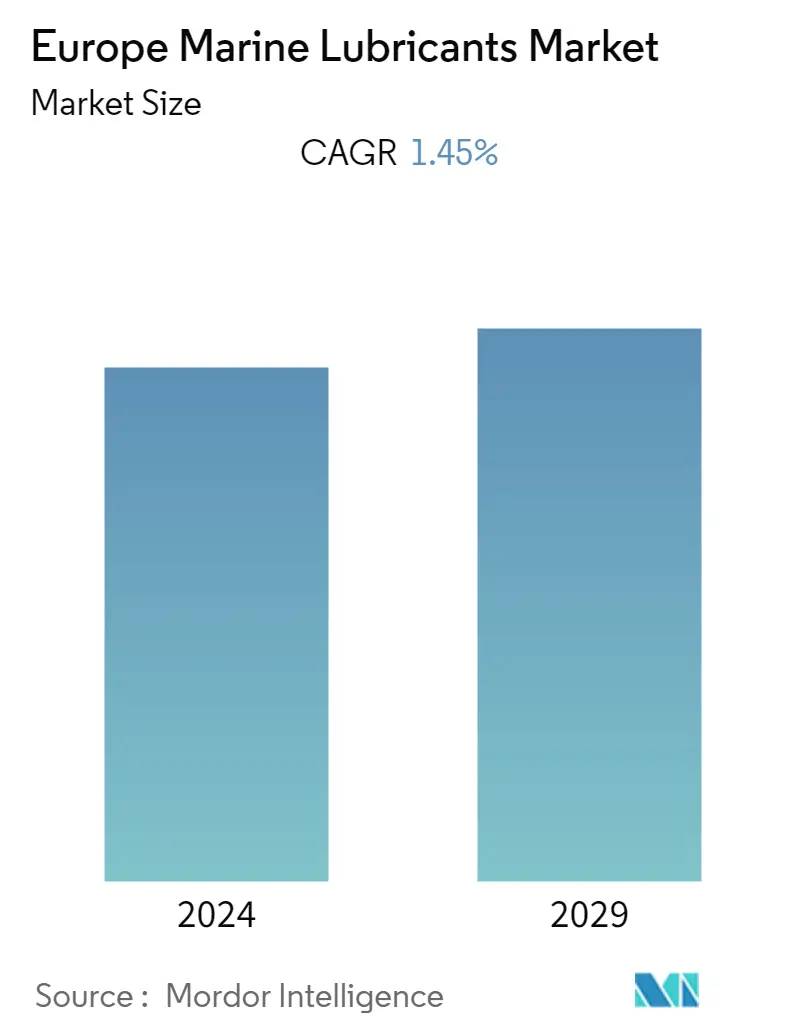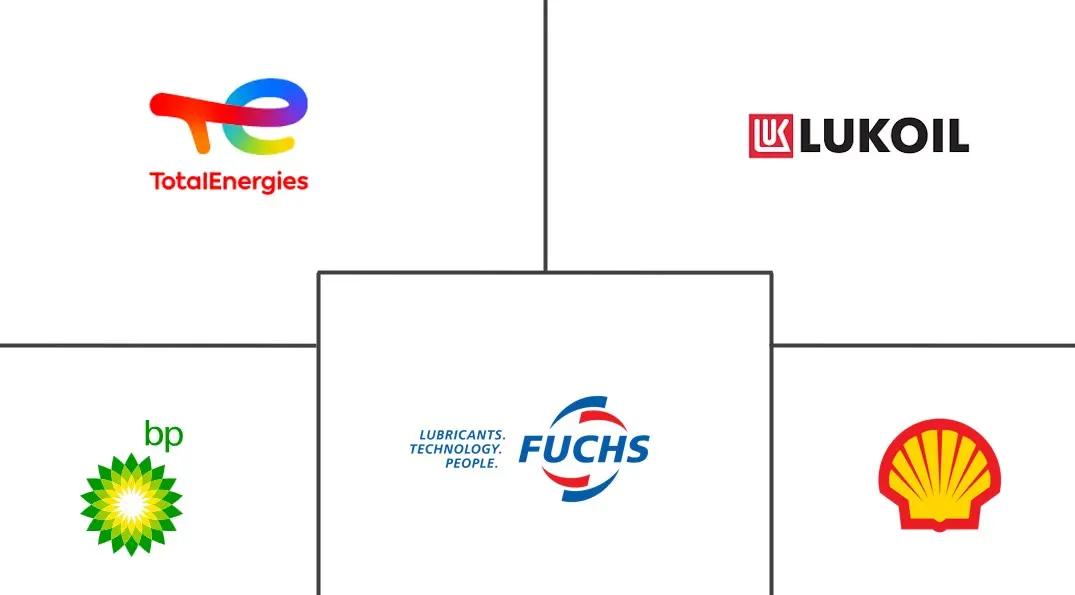Market Size of Europe Marine Lubricants Industry

| Study Period | 2019 - 2029 |
| Base Year For Estimation | 2023 |
| Forecast Data Period | 2024 - 2029 |
| Historical Data Period | 2019 - 2022 |
| CAGR | 1.45 % |
| Market Concentration | High |
Major Players
*Disclaimer: Major Players sorted in no particular order |
Europe Marine Lubricants Market Analysis
The European marine lubricants market is estimated to reach a volume of 470.47 million liters by the end of 2023, and it is projected to reach a volume of 505.58 million liters over the next five years, registering a negative CAGR of 1.45% during the forecast period.
The COVID-19 outbreak led to nationwide lockdowns and the shutdown of manufacturing plants, which hampered trade activities between nations and eventually led to supply chain disruptions. As inter-continental trade activities largely slumped, the demand for materials like marine lubricants that are used in ships and vessels for maintenance purposes also reduced. However, the market substantially improved in 2021 due to eased lockdown restrictions.
- One of the major factors that is driving the market is the rising demand for maritime transport.
- On the flip side, a rise in the number of idle ships across the region is likely to hinder the growth of the market.
- The growing research and development of bio-based lubricants, in line with the increased emphasis on sustainability, is expected to offer various growth opportunities for the market during the forecast period.
- Germany is expected to dominate the marine lubricants market in Europe, as it is the largest ship-building country in the continent.
Europe Marine Lubricants Industry Segmentation
Marine lubricants are special types of lubricants that are designed to achieve the performance required in marine vessels for optimized operations by reducing friction and wear and tear. Marine lubricants are used in different sections and processes of containers, cargo fleets, oil tankers, and other ships for lubrication purposes.
The European marine lubricants market is segmented by base stock, product type, and geography. Based on base stock, the market is segmented into mineral oil, synthetic oil, and bio-based oils. Based on product type, the market is segmented into system oils, marine cylinder lubricants, trunk piston engine oils, gear oil, greases, hydraulic fluids, and other product types (compressor and refrigeration oils, steam turbine oils, etc.). The report also covers the market size and forecasts for marine lubricants in five countries across the European region. For each segment, the market sizing and forecasts have been done in terms of volume (liters).
| Base Stock | |
| Mineral Oil | |
| Synthetic Oil | |
| Bio-Based Oils |
| Product Type | |
| System Oil | |
| Marine Cylinder Lubricants | |
| Trunk Piston Engine Oil | |
| Gear Oil | |
| Greases | |
| Hydraulic Fluids | |
| Other Product Types (Compressor and Refrigeration Oils, Steam Turbine Oils, etc.) |
| Geography | |
| Germany | |
| United Kingdom | |
| Italy | |
| France | |
| Spain | |
| Rest of Europe |
Europe Marine Lubricants Market Size Summary
The European marine lubricants market is experiencing a complex landscape influenced by various economic and geopolitical factors. The market, which faced challenges due to the COVID-19 pandemic and subsequent supply chain disruptions, has shown signs of recovery as restrictions eased. However, the market is projected to experience a slight decline over the forecast period. The demand for marine lubricants is primarily driven by the increasing need for maritime transport, which remains a crucial component of global trade. Despite this, the market faces challenges such as the rise in idle ships, which could hinder growth. Nonetheless, the development of bio-based lubricants aligns with the growing emphasis on sustainability, presenting potential growth opportunities. Germany, with its robust shipbuilding industry, is expected to lead the market in Europe, benefiting from government support and investments in innovative maritime technologies.
The European marine cargo handling sector is poised for significant expansion, supported by increased marine traffic and investments in new port infrastructure by emerging nations. The Port of Rotterdam, as the largest container-handling port in the EU, plays a pivotal role in this growth. However, geopolitical tensions, such as the Russia-Ukraine war, have negatively impacted maritime transport and, consequently, the demand for marine lubricants in the region. Germany's maritime economy, characterized by its modern shipbuilding industry and significant sea trade, is gradually recovering with government initiatives aimed at promoting zero-emission vessels and digitization. The postponement of investments in cruise ships due to the pandemic is expected to be resolved in the coming years, further boosting the demand for marine lubricants. The market is consolidated, with major players like BP PLC, Shell PLC, Total Energies, FUCHS, and LUKOIL playing significant roles in shaping its future.
Europe Marine Lubricants Market Market Size - Table of Contents
-
1. MARKET DYNAMICS
-
1.1 Market Drivers
-
1.1.1 Growing Demand for Marine Transportation
-
1.1.2 Rise in Emission Control Technologies
-
1.1.3 Other Drivers
-
-
1.2 Market Restraints
-
1.2.1 Rise in Number of Idle Ships
-
1.2.2 Other Restraints
-
-
1.3 Industry Value Chain Analysis
-
1.4 Porter's Five Forces Analysis
-
1.4.1 Threat of New Entrants
-
1.4.2 Bargaining Power of Buyers
-
1.4.3 Bargaining Power of Suppliers
-
1.4.4 Threat of Substitute Products
-
1.4.5 Degree of Competition
-
-
-
2. MARKET SEGMENTATION (Market Size in Volume)
-
2.1 Base Stock
-
2.1.1 Mineral Oil
-
2.1.2 Synthetic Oil
-
2.1.3 Bio-Based Oils
-
-
2.2 Product Type
-
2.2.1 System Oil
-
2.2.2 Marine Cylinder Lubricants
-
2.2.3 Trunk Piston Engine Oil
-
2.2.4 Gear Oil
-
2.2.5 Greases
-
2.2.6 Hydraulic Fluids
-
2.2.7 Other Product Types (Compressor and Refrigeration Oils, Steam Turbine Oils, etc.)
-
-
2.3 Geography
-
2.3.1 Germany
-
2.3.2 United Kingdom
-
2.3.3 Italy
-
2.3.4 France
-
2.3.5 Spain
-
2.3.6 Rest of Europe
-
-
Europe Marine Lubricants Market Market Size FAQs
What is the current Europe Marine Lubricants Market size?
The Europe Marine Lubricants Market is projected to register a CAGR of 1.45% during the forecast period (2024-2029)
Who are the key players in Europe Marine Lubricants Market ?
BP p.l.c., Shell plc, TotalEnergies, FUCHS and LUKOIL are the major companies operating in the Europe Marine Lubricants Market .

